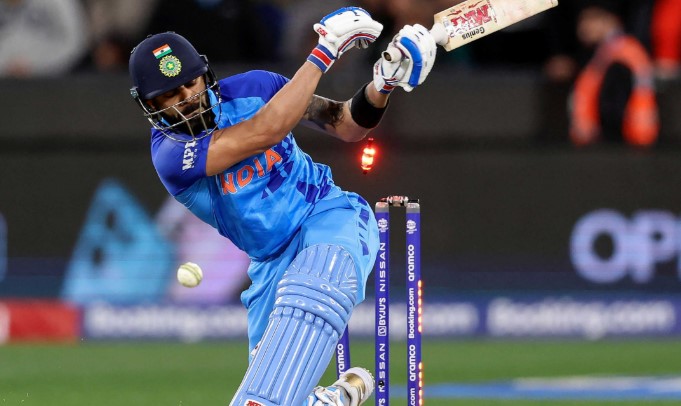Free Hit Rule: Cricket is a game with a rich history, full of evolving traditions, rules, and techniques that have changed over time to enhance the excitement and competitiveness of the sport. One such change that has gained a lot of attention in recent years is the free hit rule. Introduced to add a layer of unpredictability and drama to limited-overs cricket, the free hit rule has been a game-changer, particularly in high-stakes matches.
But what is the free hit rule, and how did it come to be? In this article, we’ll take a deep dive into the origins of the free hit rule, its evolution, and its impact on the game.
What Is The Free Hit Rule?

In simple terms, the free hit rule is a rule that allows a batsman to take a shot at a ball with no risk of being dismissed except for being run out or hitting the ball twice. It comes into play following a no-ball, usually when the bowler oversteps the crease, delivers a high full toss (above the waist), or commits other violations of the bowling laws.
When the umpire calls a no-ball, the batting team is granted a free hit on the next delivery. The key difference is that during a free hit, the batsman cannot be dismissed in the usual ways, such as being caught out, bowled, or stumped. The only ways a batsman can be dismissed during a free hit are:
- Run out (if the batsman is out of their crease while attempting a run)
- Hit the ball twice
- Obstructing the field
For a team facing a no-ball, the free hit rule effectively changes the dynamics of the game, providing the batsman with an opportunity to attack the bowler without fear of being dismissed in the typical ways.
Origins Of The Free Hit Rule
The free hit rule was first introduced in limited-overs formats in the 2007 ICC T20 World Cup. The intent was to curb the overuse of dangerous full tosses, especially those that could lead to injury. High full tosses (balls delivered above the waist) are considered dangerous, and the free hit rule was brought in as a response to the growing concern about the safety of players in limited-overs cricket.
At the time, there were increasing instances of bowlers delivering dangerous full tosses as a tactic to get the batsman out or to intimidate them. Umpires, however, had limited options for penalizing the bowler aside from calling it a no-ball. The introduction of the free hit created a more consistent and immediate consequence for these types of deliveries.

Initially, the free hit rule was only applied to high full tosses or no-balls, but it became evident that it could be a useful tool in punishing any no-ball violations by the bowler.
The Free Hit Rule Gaining Popularity (2007–2010)
While the rule was first introduced in the T20 format, its popularity quickly spread to other formats of the game. The 2007 ICC T20 World Cup saw the rule make a significant impact, especially in the finals between India and Pakistan, where the tension was high and the stakes were incredibly high.
During this period, the rule was reviewed and adjusted to refine the application. The decision to extend the rule to One-Day Internationals (ODIs) came in 2010 when the International Cricket Council (ICC) agreed to make the free hit rule applicable to all no-balls during the match. This meant that any type of no-ball, whether it was overstepping, a high full toss, or a front foot no-ball, would result in the following delivery being a free hit.
The inclusion of the free hit in ODIs brought a new dimension to limited-overs cricket. It rewarded aggressive batting and made bowlers more cautious in their deliveries. The change also led to an increase in scoring rates, as the free hit provided the batsman with a greater incentive to attack the next delivery.
Refining The Free Hit Rule (2011-2015)
As the free hit rule gained popularity, there were further refinements to ensure the rule was consistent and fair. For example, during the period between 2011 and 2015, the ICC made the following clarifications:
Bowling Restrictions: A bowler who delivers a no-ball and thus causes a free hit cannot bowl the next delivery over the same line.
No “Free Hit” for Dismissals: Although the batsman can’t be dismissed in the conventional ways (e.g., caught, bowled, stumped), the rule still allowed the umpire to enforce a free hit even if the batsman had faced the no-ball and missed.
Free Hit and Short-Pitched Deliveries: In some cases, short-pitched deliveries could also trigger the free hit rule if they were deemed dangerous.
This period was important as it helped iron out some of the gray areas in the application of the rule. There was also a push to make the rule more universally accepted and standardized across all forms of limited-overs cricket.

Modern-Day Free Hit Rule (2016 And Beyond)
Today, the free hit rule is a fixture of both ODIs and T20 cricket. Its continued success can be attributed to the excitement and unpredictability it adds to matches, making every no-ball a potentially thrilling moment. Since its introduction, the rule has been expanded to include not only high full tosses but any delivery that violates the bowler’s line.
In 2016, the ICC clarified that a free hit can also apply to a front foot no-ball. A notable change was the penalty for bowlers who repeatedly overstep the line, and the increase in the frequency of free hits has contributed to a higher emphasis on precision in bowling.
Furthermore, the free hit rule has proven particularly impactful in T20 leagues like the Indian Premier League (IPL), where its inclusion has helped foster even more dramatic moments. Batsmen, knowing they cannot be dismissed via conventional methods, often take the opportunity to hit out with greater freedom.
Impact On The Game: Strategies And Player Adaptation
The introduction of the free hit rule has had profound effects on both bowling and batting strategies.
Bowling Adaptation: Bowlers now pay extra attention to their no-ball deliveries. Front-foot no-balls are particularly scrutinized, as they result in a free hit, which can dramatically alter the course of the match. This has led to more precise bowling, particularly in critical moments.
Batting Adaptation: Batters, on the other hand, look forward to free hit balls as an opportunity to score big. Batsmen take more risks during a free hit, often attempting aggressive shots knowing that they cannot be dismissed in conventional ways.
The impact of the free hit rule has also encouraged cricket teams to review their approach to no-balls and avoid risky deliveries. It has made a no-ball even more detrimental to the bowler’s side, with the free hit acting as a powerful incentive for the batsman.

Evolution Of The Free Hit Rule
| Year | Development | Impact |
|---|---|---|
| 2007 | Introduction of the free hit rule during the ICC T20 World Cup. | Aimed to penalize dangerous high full tosses. |
| 2010 | The free hit rule extended to ODIs, covering all no-balls. | Increased excitement and scoring opportunities for batsmen. |
| 2011-2015 | Clarifications made regarding free hit applications, including bowling restrictions. | Refined the rule to ensure fair play and consistency. |
| 2016-present | Free hit rule solidified in international cricket, including the IPL. | Heightened intensity in limited-overs cricket and added a new layer of strategy. |
The Future Of The Free Hit Rule
As cricket continues to evolve, there may be additional changes to how the free hit rule is applied. The rule has already proven to be a successful tool for increasing the excitement of limited-overs cricket, especially in T20 formats. With more emphasis on fast scoring and aggressive batting, the free hit will likely continue to play a pivotal role in the dynamics of modern-day cricket.
Future refinements could include the application of the rule to even more types of violations, or it could evolve to adapt to the changing nature of the game, such as the rise of innovations like The Hundred format. For now, though, the free hit rule remains a cornerstone of limited-overs cricket, rewarding attacking cricket and punishing the bowler for errors in their delivery.

The introduction of the free hit rule in cricket marked a significant turning point in the sport, adding an exciting and strategic element to limited-overs formats. Initially designed to curb dangerous bowling and increase player safety, the free hit has since become a hallmark of modern cricket, with batsmen eagerly awaiting the opportunity to attack the next delivery without fear of conventional dismissal.
As the rule continues to evolve and shape the future of cricket, one thing is certain: it has forever changed the way the game is played, making it more thrilling and unpredictable than ever before.

